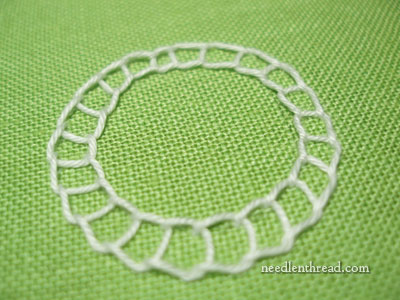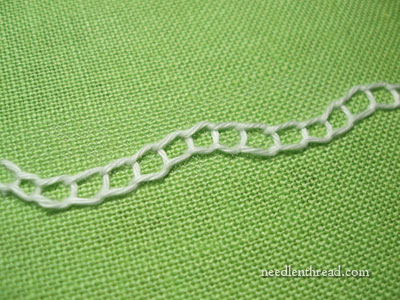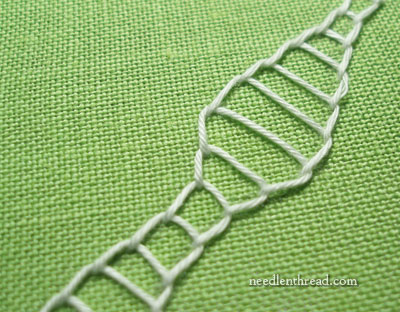The open chain stitch works well on lines, curves, and circles. It creates a square-looking stitch if space is left between the individual stitches, but you can also close up the open space between the stitches, to create a more solid-looking line.

The sample above shows open chain stitch worked in a circle. The linen used for these samples is Sotema 20L, in apple green, and the thread is a #20 coton a broder. As with any surface embroidery stitch, you can work open chain stitch on any type of fabric, with practically any type of thread.

When the width of the line equals the stitch length, the open chain stitch creates a connected line of little square stitches.

But you can also work the open chain on lines that are not parallel, creating bulges and waves in the line for an interesting effect.
Open chain stitch is a fun stitch, and it’s very quick to work. Once you get a stitching rhythm going, it works up quickly and covers a line fast! In the video, you’ll see that I use my needle as a “place holder” to tighten the stitch around, and at first, this might seem awkward, but once you do it a couple times, it’s easy. I find it much easier to use the needle to hold the stitch in place, than to pull too far on the stitch and have to straighten it out afterwards. It’s also easier than tightening up the stitch after the thread has been pulled through. Well, that’s a lot of explanation – you’ll see what I’m talking about when you watch the video and practice the stitch!
Enjoy it!
Here’s the open chain stitch video:
If you’re looking for more stitch instructions, feel free to check out the growing collection of embroidery stitch videos here on Needle ‘n Thread!
Looking for inspiration & information on hand embroidery?
There are all kinds of reasons to sign up for the Needle ‘n Thread daily newsletter! Check them out and sign up today!
If you like what you see on Needle ’n Thread, if you want to be a part of keeping the website thriving (and free of annoying network advertising), why not become a patron on Patreon? Check out my Patreon page here, where I’ll occasionally add special needlework bonuses for patrons.
If you shop on Amazon, you can support Needle ’n Thread without any extra expense to you by visiting my Amazon Recommendations page here, where you’ll find books and sundries for the needleworker available on Amazon.







Mary,
Love your videos….so much information
you can really enjoy them.
One small question….how do you close up
the chain stitch in the circle version. I
looked at the close up picture and I can’t tell
where you stopped the circle. Now granted you
are a master embroider, but do those of us who a embroidery for dummies close the circle.
Thanks a bunch…keep up the excellant work. We all benifit!
Hi, Dianna – Thanks. I’m glad you like the videos!!
To join a circle like this, for the last stitch, you take the needle and thread under (loop the thread under) the “legs” of the first stitch. It’s the concept as joining a chain stitch circle, which you can find explained here: https://needlenthread.wpengine.com/2010/10/chain-stitch-tip-circles.html If you read to the end of that article, you’ll see how the circle is joined correctly and invisibly with a chain stitch.
Hope that helps!
~MC
I am really grateful to have found your website. The quality of the videos, pictures and information is of high quality, thank you.
Where do you get the green colored linen that you are using for the pictures.
Thank you for the wonderful work you are doing
Hi, Chantal – this is an Italian linen made by Sotema. It’s not sold here in the US, and the place in Italy I originally purchased it is closed. But if you search for Sotema linen 20L, you might be able to find someone online in Italy who carries it. ~MC
Many thanks Mary
I was just looking after this stitch.
Well done!!
Michèle
HOLA TE FELICITO POR TAN BONITO TRABAJO Y GRACIAS POR COMPARTIRLO, UNA PREGUNTA PORQUE LOS VIDEOS NO SE DEJAN BAJAR QUISIERA TENERLO EN MI COMPUTADORA PARA APRENDER CON MAS TIEMPO PERO NO LO HE PODIDO HACER.
GRACIAS
TRANSLATION OF ABOVE
Hi, Congratulations on your lovely work and thank you for sharing it. A question: why is it that your videos can’t be downloaded on to my computer so that I can spend more time studying them? I haven’t been able to do it.
Hi, Alicia –
Thanks for your comment. I’m afraid I don’t offer downloadable videos at this time. They are only available for viewing on the website or on YouTube. It’s a matter of expense. It would be expensive to pay for the hosting and upkeep of that kind of service.
-MC
I am extremely thankful for finding this website. Mary where do you get your threads?
-krissy
Hi, Krissy – the threads I use for the videos are usually just DMC perle cotton, or other perle cottons I come across here and there. I just pick them up wherever I find them, if I’m in need of any. They carry them at JoAnn’s, Hobby Lobby, and similar places. I normally use #5, 8, or 12 for the videos.
You make it look so easy. I’m left handed, but I sew like a right handed person. Go figure, I just couldn’t flip flop the instructions in my head. Thank you for putting these lessons online, I really appreciate your sharing all of this information.
This is brilliant, thanks Mary. I tried several times to do this stitch and unless you know your clever technique it becomes messy very quickly. I have a Bulgarian daughter-in-law as of this week, and a new interest in eastern European embroidery. Bulgarian is very interesting too, as well as the Hungarian style, but different as Slavic, and my son and his lovely new wife bought me a kit consisting of a map of Bulgaria at Sofia airport (!) covered with patterns local to each area. I see there are similar kits online for Estonian embroidery, and maybe others too.